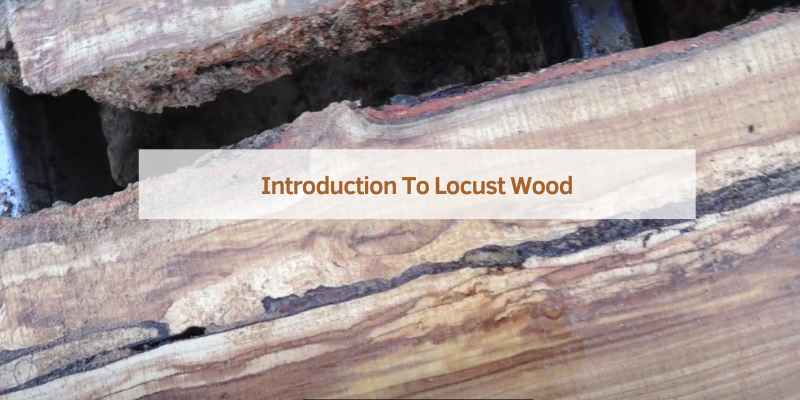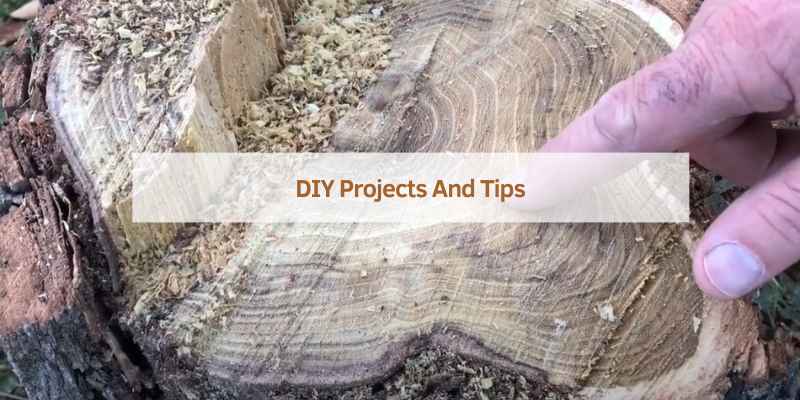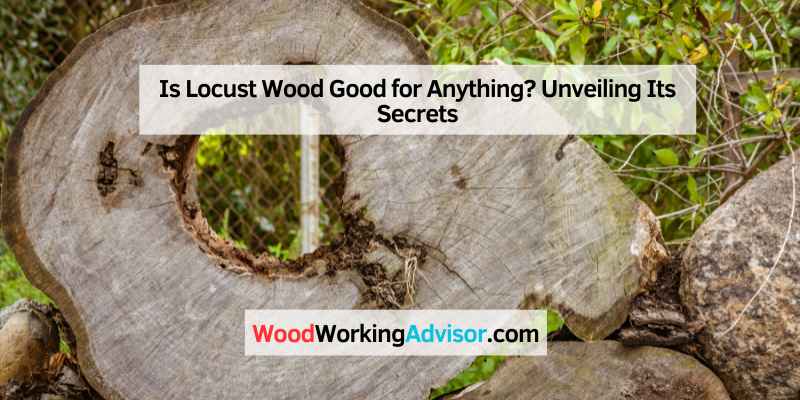Yes, locust wood is good for making furniture, fences, and outdoor decks. It is a durable and attractive hardwood with natural resistance to decay and insects.
Locust wood is known for its strength and durability, making it a popular choice for outdoor projects. Its resistance to rot and pests makes it ideal for long-lasting structures, and its attractive grain adds a touch of natural beauty to any project.
With its versatility and durability, locust wood is a valuable material for a variety of construction and woodworking applications. Whether used for furniture, fencing, or decking, locust wood offers a combination of strength and natural beauty that makes it a valuable resource for many projects.
Introduction To Locust Wood
Locust wood is highly durable and resistant to rot, making it ideal for outdoor projects like fencing and decking. Its natural strength and insect-repelling properties make locust wood a popular choice for sustainable construction and landscaping.
Locust wood, derived from the locust tree, is a versatile and durable material that has been used for various purposes throughout history. Known for its strength and resistance to rot, locust wood has gained popularity in construction, furniture making, and outdoor projects. In this article, we will explore the characteristics of locust trees and the different types of locust wood available in the market.
Characteristics Of Locust Trees
Locust trees, scientifically known as the genus Robinia, are deciduous trees that belong to the legume family. They are primarily found in North America, Europe, and Asia. Locust trees are renowned for their remarkable adaptability to different climates and soil conditions, making them a sustainable source of timber.
The following are some key characteristics of locust trees:
- Fast-growing: Locust trees have a rapid growth rate, allowing them to reach maturity quickly.
- Hardwood: The wood of locust trees is classified as a hardwood, known for its density and durability.
- Resistance to decay: Locust wood possesses natural resistance to decay, making it ideal for outdoor applications.
- High strength: The dense structure of locust wood grants it exceptional strength, making it suitable for load-bearing purposes.
- Distinct grain pattern: Locust wood showcases a beautiful and unique grain pattern, enhancing its aesthetic appeal.
Types Of Locust Wood
There are two primary types of locust wood commonly used:
- Honey Locust Wood: Honey locust wood, derived from the honey locust tree (Gleditsia triacanthos), is known for its rich golden color and striking grain pattern. It is often used in furniture making, cabinetry, and flooring due to its attractive appearance.
- Black Locust Wood: Black locust wood, obtained from the black locust tree (Robinia pseudoacacia), is highly regarded for its exceptional durability and resistance to rot. It is predominantly utilized in outdoor projects such as decking, fencing, and landscaping.
Both types of locust wood offer excellent longevity and require minimal maintenance, making them popular choices for various applications.

Historical Uses Of Locust Wood
In Ancient Civilizations
Ancient civilizations, including the Egyptians and Greeks, recognized the durability and strength of locust wood. They utilized it for constructing tools, weapons, and furniture due to its resistance to decay and its ability to withstand harsh environmental conditions.
Early American Applications
Early American settlers also valued locust wood for its remarkable strength and resistance to rot. It was often used for building fence posts, ship components, and agricultural implements, contributing to the expansion and development of the burgeoning nation.
Durability And Resistance
Locust wood is renowned for its exceptional durability and resistance.
Against Rot And Decay
Locust wood resists rot and decay exceptionally well.
Pest And Insect Resistance
Locust wood naturally repels pests and insects due to its properties.
Aesthetic Appeal
Locust wood boasts an exceptional aesthetic appeal, making it a sought-after choice for various applications. With its distinct grain patterns and rich color variations, locust wood adds a touch of natural beauty to furniture, flooring, and outdoor structures. Its durability and resistance to decay further enhance its suitability for different projects.
If you’re looking for a wood that’s not only durable but also has an attractive appearance, locust wood might just be what you need. Known for its natural beauty, locust wood can be used for a variety of purposes, including furniture, flooring, and even outdoor structures like decks and fences. In this article, we’ll take a closer look at the aesthetic appeal of locust wood, including its color, grain patterns, and finishing options.
Color And Grain Patterns
Locust wood is known for its unique color and grain patterns, which make it a popular choice for furniture makers and homeowners alike. The heartwood of locust wood is typically a light to medium brown color, with darker streaks running through it. The sapwood, on the other hand, is a pale yellow color and is often used for decorative purposes.
In terms of grain patterns, locust wood has a straight, uniform grain that gives it a clean, modern look. However, some pieces of locust wood may also have a wavy or curly grain pattern, which can add a touch of elegance and sophistication to the finished product.
Finishing And Treatment
One of the great things about locust wood is that it can be left untreated and will still last for decades. However, if you want to enhance its natural beauty and protect it from the elements, there are a variety of finishing options available. These can include staining, painting, or applying a clear coat, all of which can help to bring out the unique color and grain patterns of the wood.
When it comes to treating locust wood, there are several options available, including pressure-treated and heat-treated. Pressure-treated locust wood is treated with chemicals that help to prevent rot and insect damage, making it a popular choice for outdoor structures like decks and fences. Heat-treated locust wood, on the other hand, is treated with heat and steam, which helps to improve its durability and stability.
In conclusion, locust wood is not only a durable and long-lasting material but also has a unique and attractive appearance that makes it a popular choice for a variety of purposes. Whether you’re looking to build a deck, create a piece of furniture, or add some decorative accents to your home, locust wood is definitely worth considering.
Modern Applications
Locust wood, known for its durability and natural resistance to decay, has various modern applications. Its strength and versatility make it a popular choice in construction, furniture making, and outdoor structures.
In Construction
Locust wood is highly valued in the construction industry due to its exceptional strength and resistance to rot, making it suitable for a range of applications. It is commonly used for:
- Decking and flooring
- Support beams and joists
- Outdoor structures such as pergolas and gazebos
- Retaining walls and fences
With its natural resistance to moisture and insects, locust wood provides long-lasting durability to these construction projects, reducing the need for frequent maintenance and replacement.
Furniture Making
Locust wood’s attractive appearance and durability make it a sought-after material for furniture making. Its natural resistance to decay and insects ensures the longevity of furniture pieces. Locust wood is often used to craft:
- Dining tables and chairs
- Outdoor furniture sets
- Cabinetry and shelving
- Bed frames
The unique grain patterns and rich color variations of locust wood add character to furniture, making it an appealing choice for both indoor and outdoor settings.
Outdoor Structures
Due to its exceptional durability and resistance to weathering, locust wood is commonly utilized in the construction of outdoor structures. These include:
- Decks and patios
- Arbors and trellises
- Playground equipment
- Bridge and dock construction
The strength and natural resistance of locust wood allow these outdoor structures to withstand constant exposure to the elements, ensuring their longevity and safety.
Environmental Impact
Locust wood is a durable and resilient material that has been used for centuries in construction and furniture making. However, its impact on the environment is a concern, as the harvesting of locust wood can lead to deforestation and habitat destruction.
While locust wood may be useful for certain applications, it is important to consider its environmental impact before using it.
Sustainability Of Harvesting
Locust wood harvesting methods must prioritize sustainability.
Impact On Local Ecosystems
Locust wood harvesting can disrupt local ecosystems.
Comparative Analysis
Locust wood, known for its durability and resistance to decay, is commonly used in outdoor furniture and fence construction. Its strength and insect-repellent properties make it a good choice for outdoor projects. However, its availability can vary regionally, so a comparative analysis may be necessary to determine its suitability for specific applications.
Locust wood is a dense hardwood that is commonly found in North America. While it is not as well-known as other hardwoods like oak or maple, it has become increasingly popular in recent years for its strength and durability. In this comparative analysis, we will examine the benefits of locust wood against other hardwoods and from a cost-benefit perspective.
Against Other Hardwoods
When compared to other hardwoods, locust wood has some distinct advantages. Its density and strength make it ideal for use in outdoor furniture, decking, and fence posts. It is also resistant to rot, decay, and insect damage, which makes it a popular choice for outdoor projects.
In contrast, oak is a popular hardwood that is known for its strength and durability. However, it is not as resistant to decay and insect damage as locust wood. Maple, another popular hardwood, is not as dense as locust wood, which makes it less suitable for outdoor projects that require strength and durability.
Cost-benefit Perspective
From a cost-benefit perspective, locust wood can be a good investment for outdoor projects. While it may be more expensive than other types of wood, its strength and durability mean that it will last longer and require less maintenance over time. This can ultimately save you money in the long run.
In addition, locust wood is an eco-friendly choice. It is a renewable resource that is grown sustainably in North America. This means that it has a lower carbon footprint than other types of wood that may be imported from other countries.
Overall, locust wood is a versatile and durable hardwood that has many benefits. Whether you are looking for a strong and long-lasting material for outdoor furniture or decking, or you want an eco-friendly option for your next project, locust wood is definitely worth considering.
DIY Projects And Tips
DIY projects and tips are a great way to utilize locust wood, a hardwood species known for its durability and resistance to rot, making it an ideal choice for outdoor projects. Whether you’re looking to build a garden bed or a patio deck, locust wood can be a great option. In this article, we’ll cover tips for selecting the right wood, as well as maintenance and care to ensure the longevity of your DIY project.
Selecting The Right Wood
When selecting locust wood for your DIY project, it’s important to choose the right grade of wood. The highest grade, known as clear, has no knots or other imperfections, making it the strongest and most durable option. The next grade down, known as select, has some knots and minor imperfections but is still a good choice for DIY projects. Finally, the lowest grade, known as common, has more knots and imperfections and is best used for projects where strength is not a top priority.
Maintenance And Care
To ensure the longevity of your locust wood DIY project, it’s important to properly maintain and care for the wood. This includes regular cleaning, sealing, and staining. Cleaning the wood with a mild detergent and water can help remove dirt and debris, while sealing the wood can help prevent moisture from penetrating the surface. Staining the wood can also help protect it from the elements and prevent fading.
Overall, locust wood can be a great choice for DIY projects, especially those that will be used outdoors. By selecting the right grade of wood and properly maintaining and caring for it, you can ensure the longevity and durability of your project for years to come.

Frequently Asked Questions
Is Locust Wood Good For Outdoor Furniture?
Yes, locust wood is excellent for outdoor furniture due to its natural resistance to decay, rot, and insects. It’s a durable hardwood that can withstand various weather conditions, making it an ideal choice for outdoor furniture, such as benches and tables.
What Are The Benefits Of Using Locust Wood For Decking?
Using locust wood for decking offers several benefits, including exceptional durability, natural resistance to decay and pests, and minimal maintenance requirements. It’s an eco-friendly option that can enhance the aesthetic appeal of outdoor spaces while providing long-lasting performance.
Can Locust Wood Be Used For Firewood?
Locust wood is an excellent choice for firewood, as it burns hot and clean with minimal smoke. It’s known for its high energy content and long-lasting burn time, making it a popular option for heating and cooking. Additionally, its dense nature makes it suitable for use in wood-burning stoves and fireplaces.
Conclusion
Locust wood offers durability and natural resistance to pests and decay. Its versatile uses in outdoor projects make it a popular choice among builders and homeowners. Consider incorporating Locust wood into your next project for its strength and longevity.


